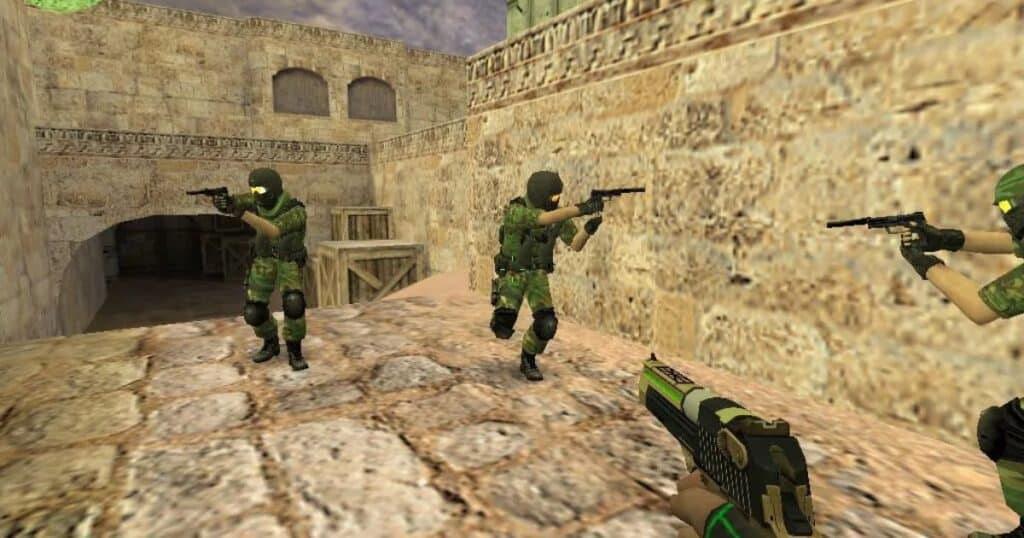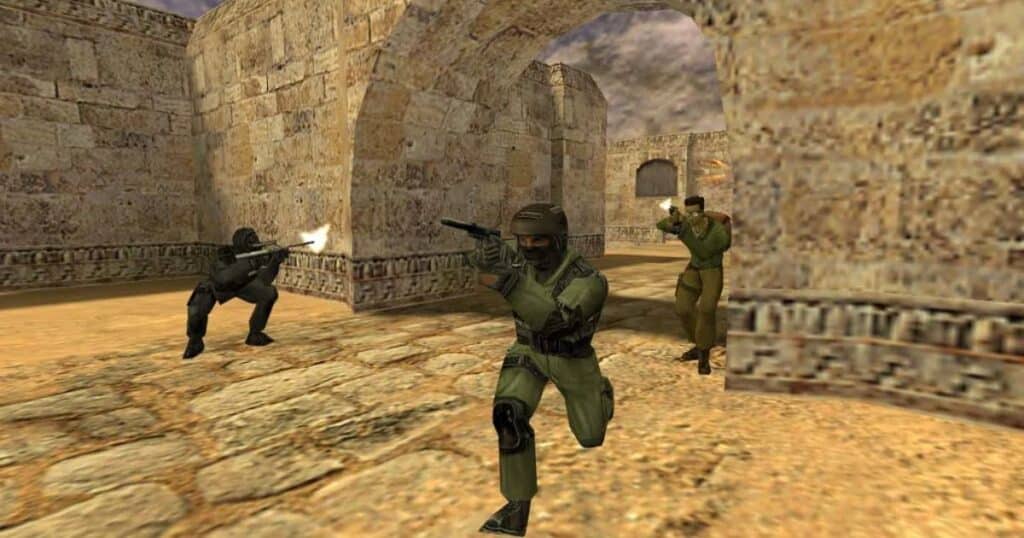Counter-Strike 1.6, released in 2003, is a legendary first-person shooter that has left a lasting impact on gaming culture. One of its most memorable aspects is its game icons and banners. These visual elements became symbols of the game itself, representing the thrilling, competitive spirit of Counter-Strike.
From the distinctive player models to the iconic logo, the visuals were simple yet effective, creating a lasting impression on gamers worldwide. These icons and banners weren’t just graphics; they became emblems of a community and a culture that thrived on tactical gameplay and teamwork.
The Evolution of Counter-Strike Icons
The icons of Counter-Strike have evolved significantly since its early days. Initially, they were rudimentary, designed to fit the technical limitations of the time. As the game progressed, these icons became more sophisticated, reflecting the game’s growing complexity and the community’s increasing expectations.
Each iteration brought a new level of detail and polish, enhancing the visual appeal without losing the essence of what made the originals so beloved. This evolution mirrors the game’s journey from a simple mod to a cornerstone of competitive gaming.
Gameplay Mechanics and Quality That Made Counter-Strike 1.6 a Hit
Counter-Strike 1.6’s gameplay mechanics were groundbreaking and set the standard for first-person shooters. The game emphasized precision, strategy, and skill, making every match a test of wits and reflexes.
The quality of its gameplay was evident in its balanced weapons, realistic physics, and tight controls. Players were drawn to its depth and the way it rewarded practice and teamwork. The game’s simplicity in design yet depth in strategy created an experience that was easy to pick up but challenging to master, securing its place as a favorite among gamers.
Tactical Gameplay and Team Dynamics
The tactical gameplay and team dynamics of Counter-Strike 1.6 were key to its enduring popularity. Unlike many shooters of its time, it required players to work together, plan strategies, and communicate effectively. Success in the game wasn’t just about individual skill; it was about how well a team could coordinate and execute their plans.
This emphasis on teamwork created a unique and compelling experience, fostering a strong community of players who valued cooperation and strategic thinking. The game’s design encouraged players to think like a team, making each victory a shared achievement.
Team-Based Objectives
In Counter-Strike 1.6, team-based objectives were central to the gameplay experience. Each match involved two teams: terrorists and counter-terrorists, each with distinct goals. Whether planting or defusing bombs, rescuing hostages, or securing strategic locations, these objectives required coordinated efforts.
Players had to communicate and plan their moves, ensuring that individual actions aligned with the team’s strategy. This focus on team-based objectives not only made the gameplay more immersive and challenging but also fostered a strong sense of camaraderie and teamwork among players.
Economy System
The economy system in Counter-Strike 1.6 added a layer of strategic depth that set it apart from other shooters. At the start of each round, players earned money based on their performance, which they could spend on weapons, armor, and equipment.
Managing this in-game currency was crucial, as it influenced a team’s strength and strategy for upcoming rounds. Teams had to decide whether to save money and play conservatively or spend it all to gain an immediate advantage. This economic aspect introduced a tactical dimension, where decisions made in one round could significantly impact the outcome of future rounds.
Weapon Variety and Balance
Counter-Strike 1.6 featured a diverse arsenal of weapons, each with its own strengths, weaknesses, and unique handling characteristics. From pistols to rifles, shotguns to sniper rifles, the game offered a wide range of choices that catered to different play styles and tactical needs.
Importantly, the game maintained a careful balance, ensuring no single weapon dominated the battlefield. This balance allowed players to experiment with different loadouts and strategies, keeping the gameplay fresh and engaging. The variety and balance of weapons were key factors in the game’s enduring appeal.
Pistols and Rifles

Pistols and rifles played crucial roles in the gameplay dynamics of Counter-Strike 1.6. Pistols, typically used in the early rounds or when funds were low, required precision and often dictated the pace of the initial engagements. Rifles, on the other hand, were the mainstay of most rounds, offering greater firepower and versatility.
Weapons like the AK-47 and M4A1 became iconic, known for their reliability and effectiveness. The interplay between using pistols in tight budget scenarios and rifles for more aggressive strategies highlighted the game’s tactical depth, making each round a unique challenge.
Grenades and Equipment
Grenades and equipment in Counter-Strike 1.6 added significant strategic depth to the gameplay. Players had access to various grenades, such as flashbangs, smoke grenades, and high-explosive grenades, each serving a specific tactical purpose. Flashbangs could temporarily blind opponents, smoke grenades created cover or blocked vision, and high-explosive grenades dealt damage.
Additionally, equipment like defuse kits and body armor played critical roles in gameplay. The effective use of these tools required careful planning and timing, often turning the tide of a match. This variety of equipment allowed for complex strategies and added layers of tactical nuance to the game.
Skill-Based Mechanics
Counter-Strike 1.6 was renowned for its skill-based mechanics, making it a game where practice and precision were crucial. Players needed to master various aspects, such as aiming, shooting, and map knowledge, to excel. The game’s mechanics rewarded those who could consistently land headshots, control their movement, and make strategic decisions under pressure.
Unlike many modern shooters, there were no perks or power-ups to give players an edge; success depended entirely on individual skill and teamwork. This emphasis on skill made victories in Counter-Strike 1.6 particularly satisfying and fostered a competitive spirit among players.
Recoil and Spray Control
Recoil and spray control were essential components of the shooting mechanics in Counter-Strike 1.6. Each weapon had a distinct recoil pattern that players had to learn and master to maintain accuracy during sustained fire. This required players to practice controlling their mouse movements precisely to counteract the weapon’s natural upward and sideways motion. Mastery of spray patterns allowed players to maintain accuracy while firing multiple shots, giving them an edge in firefights. This focus on recoil and spray control added a layer of depth to the gameplay, making it both challenging and rewarding for those who took the time to develop their skills.
Movement and Positioning
Movement and positioning were critical elements in Counter-Strike 1.6, influencing both survival and success in the game. Players had to master the art of strafing, crouching, and peeking around corners to gain tactical advantages. Good positioning could mean the difference between winning and losing a firefight.
Understanding the maps, knowing the best spots for cover, and predicting enemy movements were all crucial skills. Effective movement and positioning allowed players to control engagements, outmaneuver opponents, and support their team more efficiently. These elements combined to create a highly strategic and dynamic gameplay experience.
Community and Mod Support
The community and mod support for Counter-Strike 1.6 played a pivotal role in its enduring success. From the outset, the game fostered a vibrant community of players, modders, and map creators who continuously enriched the game with new content.
This community-driven approach kept the game fresh and engaging, as players could always find new experiences and challenges. Valve’s openness to mods allowed for a wide variety of custom content, ensuring that Counter-Strike 1.6 evolved along with its player base. This strong community support created a sense of ownership and connection among players, helping the game thrive for many years.
Custom Maps and Mods
Custom maps and mods were central to the Counter-Strike 1.6 experience, providing endless variety and creativity. Talented map designers and modders crafted unique environments and gameplay modes that extended the game’s life far beyond its original release.
Popular custom maps like “de_dust2_long” and “cs_rats” became staples in the community, offering new tactical challenges and fun scenarios. Mods introduced new gameplay mechanics and features, from zombie survival modes to intricate puzzle maps. This wealth of custom content allowed players to explore countless new possibilities, ensuring that the game remained engaging and diverse.
Competitive Scene
The competitive scene in Counter-Strike 1.6 was one of the most vibrant and influential in gaming history. The game quickly became a staple in esports, with tournaments and leagues emerging around the world. Professional teams and players gained fame for their skills and strategies, drawing large audiences and passionate fan bases. Events like the World Cyber Games and the Electronic Sports World Cup showcased the highest levels of play, setting standards for competitive gaming. The game’s emphasis on skill, teamwork, and strategy made it perfect for competition, and its legacy continues to influence modern esports.
Thrilling Game Modes That Kept Players Hooked on Counter-Strike 1.6

Counter-Strike 1.6 offered a variety of thrilling game modes that kept players hooked for hours on end. The classic Bomb Defusal mode required terrorists to plant a bomb while counter-terrorists tried to prevent or defuse it, creating intense, high-stakes gameplay. Hostage Rescue mode added a different challenge, with counter-terrorists needing to save hostages from terrorist captors.
Each mode demanded different tactics and teamwork, keeping the gameplay dynamic and exciting. Additionally, custom game modes, like Gun Game and Surf Maps, provided fun and innovative ways to play, ensuring that there was always something new and engaging for players to enjoy.
Classic Game Modes
Counter-Strike 1.6 featured classic game modes that became synonymous with the series and defined the multiplayer experience for millions of players. These modes included Bomb Defusal, where terrorists attempted to plant a bomb at designated sites while counter-terrorists aimed to prevent or defuse it, and Hostage Rescue, where counter-terrorists had to rescue hostages held by terrorists. These modes provided the foundation for intense, tactical gameplay and fostered a competitive atmosphere that kept players engaged for years.
Also Read: Unlocking the Secrets of 127.0.0.1:62893: Utilizing Localhost for Effortless Testing
Custom Game Modes
In addition to its classic modes, Counter-Strike 1.6 also embraced custom game modes created by the community, adding diversity and excitement to the gameplay experience. Custom modes like Zombie Escape, Surf, and Deathmatch offered unique challenges and gameplay mechanics that appealed to a wide range of players. These custom modes encouraged creativity and experimentation, allowing players to explore new ways to enjoy the game and fostering a sense of camaraderie within the community.
Competitive and Community-Driven Modes
Counter-Strike 1.6’s competitive and community-driven modes played a vital role in its longevity and popularity. The game’s competitive scene, characterized by tournaments and leagues, provided a platform for players to showcase their skills and compete at the highest level.
Meanwhile, community-driven modes like Gun Game and Jailbreak offered casual players opportunities for fun and social interaction. These modes enriched the overall gameplay experience, catering to both competitive and casual players and contributing to the game’s lasting appeal.
Banners that Defined a Generation
The banners of Counter-Strike 1.6, from its iconic logo to its distinctive player models, served as symbols of a generation of gamers. These banners encapsulated the spirit of the game, representing its intensity, camaraderie, and competitive spirit.
For many players, seeing these banners evokes memories of countless hours spent in fierce battles and memorable moments shared with friends. The banners of Counter-Strike 1.6 not only defined a generation of gaming but also left an indelible mark on the broader culture of esports and multiplayer gaming.
The Classic Logo Banner
The classic logo banner of Counter-Strike 1.6 is an enduring symbol of the game’s legacy. Featuring a bold, minimalist design with distinctive typography, the logo immediately captures the essence of the Counter-Strike experience. It represents the game’s intense, tactical gameplay and its status as a pioneer in the world of esports.
For many players, the logo banner evokes a sense of nostalgia and fond memories of countless battles fought on virtual battlegrounds. It remains a timeless icon that continues to inspire and resonate with gamers around the world.
Tournament and Event Banners
Tournament and event banners in Counter-Strike 1.6 were more than just promotional graphics; they were symbols of prestige and competition. These banners adorned arenas and websites, announcing the arrival of epic battles between the world’s best teams.
From the World Cyber Games to the Electronic Sports World Cup, these events showcased the highest levels of skill and strategy, drawing massive audiences and shaping the future of esports. The banners served as beacons of excitement and anticipation, rallying fans and players alike to witness history in the making.
Community and Clan Banners
Community and clan banners in Counter-Strike 1.6 were badges of honor for players, representing their allegiance and identity within the game’s vast community. Whether created for casual groups of friends or elite competitive teams, these banners were symbols of camaraderie and teamwork.
They adorned player profiles, forums, and servers, fostering a sense of belonging and pride among members. Community and clan banners were more than just graphics; they were emblems of friendship, rivalry, and shared experiences that enriched the social fabric of the game.
Conclusion: Counter-Strike 1.6 (2003) Game Icons Banners
Counter-Strike 1.6’s game icons banners are more than just visual elements; they are symbols of a cultural phenomenon that continues to captivate gamers worldwide. From the classic logo banner to the banners of tournaments, events, communities, and clans, each graphic represents a unique facet of the game’s rich tapestry. Together, these banners form a visual legacy that reflects the game’s enduring influence and significance in the world of gaming and esports. Counter-Strike 1.6 will always be remembered not only for its groundbreaking gameplay but also for the iconic banners that defined an era.







